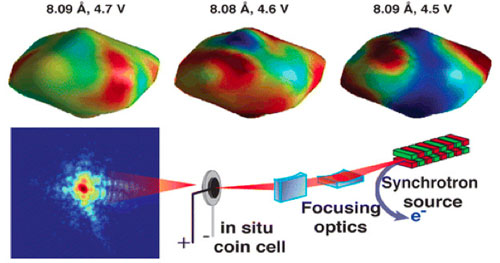| Posted: Sep 26, 2014 |
New imaging capability reveals possible key to extending battery lifetime, capacity
|
|
(Nanowerk News) Lithium ion batteries power mobile devices and electric cars and help to store energy from renewable, yet intermittent sources of energy such as wind and solar. But many cycles of charging and discharging lead to battery failures and capacity loss, limiting their useful life.
|
|
A novel X-ray technique used at the U.S. Department of Energy’s Advanced Photon Source has revealed surprising dynamics in the nanomechanics of operating batteries and suggests a way to mitigate battery failures by minimizing the generation of elastic energy.
|
 |
| Three-dimensional strain evolution in situ of a single LiNi0.5Mn1.5O4 nanoparticle in a coin cell battery under operando conditions during charge/discharge cycles with coherent X-ray diffractive imaging.
|
|
Lithium ions strain the material as they shuttle between electrodes and can even alter its structure, which lead to defects. Designs for more resilient electrodes will rely on fundamental understanding of the interactions between lithium ions and electrodes within the structure of a battery. But until now scientists have been unable to sufficiently characterize single nanoparticle behavior in batteries under real operating conditions.
|
|
Using coherent X-ray diffractive imaging, a team of researchers for the APS, the University of California-San Diego, SLAC National Accelerator Laboratory and the Center for Free-Electron Laser Science mapped the three-dimensional strain in individual nanoparticles within the electrodes of operating coin cell batteries, like those found in watches. In a paper recently published in Nano Letters ("Single Particle Nanomechanics in Operando Batteries via Lensless Strain Mapping"), the team reported evidence that the history of charge cycles alters the patterns of strain in single particles of the electrode material.
|
|
This new approach will help to reveal fundamental processes underlying the transfer of electrical charge, insight that could help to guide the design of economical batteries with longer useful lives.
|
|
This discovery was only made possible by the ability to use extend the use of CDI to study batteries cycling under read operating conditions.
|
|
The APS is one of the few places where this research can be done.
|
|
“Bragg Coherent Diffraction imaging (Bragg-CDI) is a technique that only uses the coherent part of the beam. Furthermore, it can pick out single nanocrystals based on their crystal structure, and map out the evolution of strain inside the nanostructure as the whole battery is cycled.” said Ross Harder, an author on the papers and X-ray physicist at the APS. “The high brilliance of the APS at high photon energies is a necessary requirement to pursue this kind of research on individual nanoparticles inside their intact matrix. The APS Upgrade with will allow us look at nanoscale systems of this complex nature with orders of magnitude increased speed, sensitivity and resolution, “ said Jörg Maser, co-author on the papers and X-ray physicist at the APS.
|

